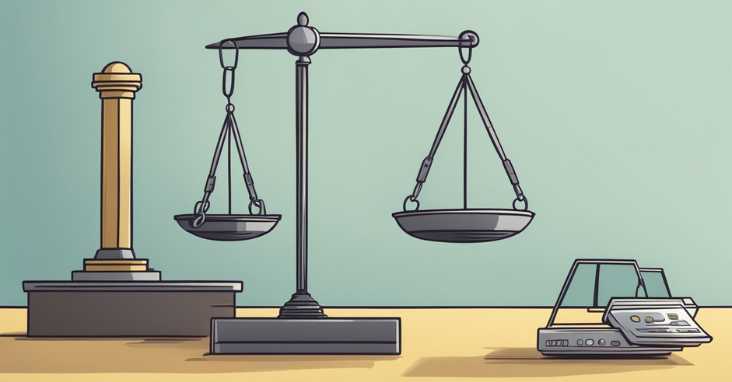What makes a strong retaliation case ? A strong retaliation case hinges on clear evidence of unfair treatment following a complaint, legal compliance, and a direct link between complaint and repercussion.
Retaliation in the workplace is a serious issue that affects many employees. When an employee engages in a protected activity, such as reporting discrimination or harassment, they are legally protected from retaliation by their employer. However, retaliation can take many forms and can be difficult to prove. In order to build a strong retaliation case, employees must understand the legal framework governing retaliation cases and the actions that constitute retaliation.

Understanding Retaliation in the Workplace:
Retaliation occurs when an employer takes an adverse action against an employee for engaging in a protected activity. Adverse actions can include termination, demotion, reduction in pay, or other negative consequences. In order for an employee to have a strong retaliation case, they must be able to prove that the adverse action was a direct result of their protected activity.
Legal Framework Governing Retaliation Cases:
There are several federal laws that protect employees from retaliation, including Title VII of the Civil Rights Act, the Americans with Disabilities Act, and the Age Discrimination in Employment Act. Each of these laws has specific provisions related to retaliation, and employees must understand their rights and the legal requirements for proving retaliation in order to build a strong case.
Key Takeaways
- Understanding the legal framework governing retaliation cases is essential for building a strong case.
- Employees must be able to prove that the adverse action was a direct result of their protected activity.
- Federal laws, such as Title VII of the Civil Rights Act, protect employees from retaliation.
Understanding Retaliation in the Workplace
Retaliation in the workplace is a serious issue that can affect anyone at any time. Understanding what constitutes retaliation and how it can be prevented is essential for employees and employers alike. This section will provide an overview of retaliation in the workplace, defining retaliation and protected activities, and common forms of retaliation.
Defining Retaliation and Protected Activities
Retaliation occurs when an employer takes adverse action against an employee who has engaged in a protected activity. Protected activities include any action taken by an employee to oppose discrimination or harassment in the workplace, or to assert their rights under employment laws. These activities can include filing a complaint with HR, reporting discrimination or harassment, participating in an investigation, or refusing to follow an order that would result in discrimination or harassment.
Retaliation can take many forms, including termination, demotion, pay reduction, denial of promotion, or other adverse actions that could dissuade an employee from engaging in protected activities. It is important to note that retaliation can occur even if the underlying complaint of discrimination or harassment is found to be unfounded.
Common Forms of Retaliation
Retaliation can take many forms, and it is not always obvious. Some common forms of retaliation include:
- Exclusion from meetings or events
- Increased scrutiny or monitoring of work
- Increased workload or unreasonable expectations
- Negative performance evaluations
- Denial of training or opportunities for advancement
- Intimidation or threats
It is important for employers to be aware of the potential for retaliation and to take steps to prevent it from occurring. This can include creating a workplace culture that encourages open communication, providing training to employees and managers on retaliation and protected activities, and establishing a clear process for reporting and investigating complaints of retaliation.
For more information on retaliation in the workplace, visit the Equal Employment Opportunity Commission website.
Legal Framework Governing Retaliation Cases
Retaliation cases are governed by a complex legal framework that includes both federal and state laws. This section will provide an overview of the legal framework governing retaliation cases, including the role of the Equal Employment Opportunity Commission (EEOC) and the legal process involved in pursuing a retaliation claim.
Employment Law and Retaliation
Retaliation is a violation of employment law, which prohibits employers from taking adverse actions against employees who engage in protected activity. Protected activity includes actions such as filing a complaint of discrimination or harassment, participating in an investigation of discrimination or harassment, or opposing discriminatory practices.
Employment law provides employees with the right to file a retaliation claim against their employer if they believe they have been retaliated against for engaging in protected activity. Retaliation claims can be pursued in both federal and state courts, and can result in significant damages for the employee if successful.
Role of the Equal Employment Opportunity Commission
The EEOC is a government agency responsible for enforcing federal laws that prohibit employment discrimination. The EEOC also investigates retaliation claims filed by employees against their employers.
Employees who believe they have been retaliated against can file a charge of retaliation with the EEOC. The EEOC will investigate the claim and may file a lawsuit on behalf of the employee if it finds evidence of retaliation.
It is important to note that employees must file a charge of retaliation with the EEOC before pursuing a retaliation claim in court. Failing to file a charge with the EEOC can result in the dismissal of a retaliation claim in court.
Overall, understanding the legal framework governing retaliation cases is essential for employees who believe they have been retaliated against. By working with an experienced employment law attorney and filing a charge with the EEOC, employees can pursue a retaliation claim and hold their employer accountable for their actions.
Here is a link to the EEOC’s website on retaliation, which provides additional information on this topic.
Building a Strong Retaliation Case
Retaliation cases can be challenging to prove, but with the right evidence and witnesses, a strong case can be built. In this section, we will discuss the key elements required to build a strong retaliation case.
Gathering and Preserving Evidence
The first step in building a strong retaliation case is to gather and preserve all relevant evidence. This includes emails, memos, personal notes, text messages, and journal entries that document any retaliatory actions taken against the employee. It is important to keep all evidence organized and in a safe place to ensure that it is not lost or destroyed.
One effective way to gather and preserve evidence is to create a timeline of events. This can be done by documenting the dates and times of any retaliatory actions taken against the employee, as well as the names of any witnesses who observed these actions. A timeline can help establish a pattern of retaliation and make it easier to present the evidence in a clear and concise manner.
Identifying Witnesses and Testimonies
In addition to gathering and preserving evidence, it is important to identify witnesses who can provide testimony to support the employee’s retaliation claim. Witnesses can include coworkers, supervisors, and anyone else who observed the retaliatory actions taken against the employee.
When identifying witnesses, it is important to consider their credibility and reliability. Witnesses who have a history of lying or have a personal bias may not be viewed as credible by a judge or jury. It is also important to consider whether the witness’s testimony will be admissible in court.
One effective way to identify witnesses is to interview coworkers and supervisors who were present during the retaliatory actions. It is important to document these interviews and keep them organized for future reference.
In conclusion, building a strong retaliation case requires gathering and preserving evidence, as well as identifying credible witnesses who can provide testimony to support the employee’s claim. By following these steps, employees can increase their chances of success in the complaint process. For more information on retaliation cases, visit EEOC’s Retaliation page.
Employee Rights and Employer Obligations

Understanding Worker Protections
Employees are protected from retaliation under various federal and state laws. These laws prohibit employers from retaliating against employees who engage in protected activities, such as reporting discrimination or harassment, participating in an investigation, or filing a complaint. It is important for workers to understand their rights and the protections afforded to them under these laws.
One of the most important federal laws protecting workers from retaliation is Title VII of the Civil Rights Act of 1964. This law prohibits employers from retaliating against employees who report discrimination or harassment based on race, color, religion, sex, or national origin. Other federal laws that protect employees from retaliation include the Age Discrimination in Employment Act, the Americans with Disabilities Act, and the Family and Medical Leave Act.
In addition to federal laws, many states have their own laws protecting employees from retaliation. These laws may provide additional protections or cover different types of retaliation. It is important for employees to be aware of the laws in their state and how they apply to their situation.
Employer Responsibilities to Prevent Retaliation
Employers have a responsibility to prevent retaliation and protect employees who engage in protected activities. This includes implementing policies and procedures to prevent retaliation, investigating complaints of retaliation, and taking appropriate action to address any retaliation that occurs.
Employers should also provide training to managers and supervisors on how to recognize and prevent retaliation. This training should cover the company’s policies and procedures, as well as the legal requirements for preventing retaliation.
One important way that employers can prevent retaliation is by creating a culture of respect and inclusion in the workplace. This includes promoting diversity and inclusion, providing clear expectations for behavior, and holding employees accountable for their actions.
Overall, it is important for both employers and employees to understand their rights and responsibilities when it comes to retaliation. By working together to prevent retaliation and create a positive workplace culture, employers and employees can help ensure that everyone is treated with respect and dignity.
For more information on employee rights and employer obligations, visit the Equal Employment Opportunity Commission.
Actions Constituting Retaliation

Retaliation occurs when an employer takes negative action against an employee for engaging in protected activity. Protected activity includes reporting discrimination, harassment, or other unlawful conduct, participating in an investigation, or asserting a legal right. Retaliation can take many forms, and it is important to understand what actions constitute retaliation.
Adverse Employment Actions
Adverse employment actions are tangible actions taken by an employer that have a negative impact on an employee’s job. These actions include termination, demotion, pay cut, job assignments, reduction in salary, reduction in hours, discipline, transfer, or any other negative action that affects an employee’s job. It is important to note that adverse employment actions can occur even if the employer does not intend to retaliate against the employee.
Subtle Forms of Workplace Retaliation
Subtle forms of workplace retaliation are actions that are not tangible but still have a negative impact on an employee’s job. These actions include threatening an employee, giving them poor performance evaluations, excluding them from meetings or training, or any other action that creates a hostile work environment. Subtle forms of retaliation can be difficult to prove, but they can still have a significant impact on an employee’s job.
It is important for employees to understand what actions constitute retaliation and to document any instances of retaliation. If an employee believes they have been retaliated against, they should speak with a supervisor or HR representative. If the issue is not resolved, they may need to file a complaint with the Equal Employment Opportunity Commission (EEOC) or a state agency.
For more information on what actions constitute retaliation, please visit EEOC.
Responding to Retaliation

Retaliation in the workplace can take many forms, from unfair treatment to discriminatory behavior. When an employee believes they have been retaliated against, it is important to take action in order to protect their rights. This section will cover two key steps that an employee can take when responding to retaliation: filing a complaint and seeking legal consultation.
Filing a Complaint
One of the first steps an employee should take when they believe they have been retaliated against is to file a complaint. This can be done through their employer’s internal complaint process or with an outside agency, such as the Equal Employment Opportunity Commission (EEOC). Filing a complaint can help to document the employee’s claims and initiate an investigation into the alleged retaliation.
It is important for employees to understand that filing a complaint can be a complex process, and it may be helpful to seek the guidance of an experienced Los Angeles employment attorney. A lawyer can help the employee to navigate the complaint process and ensure that their rights are protected.
Seeking Legal Consultation
If an employee believes they have been retaliated against, it may be helpful to seek legal consultation. A lawyer can help the employee to understand their legal rights and options, and can provide guidance on the best course of action to take.
When seeking legal consultation, it is important to choose a lawyer who has experience in employment discrimination and retaliation claims. A lawyer who is knowledgeable in this area can provide valuable guidance and representation throughout the legal process.
It is also important to choose a lawyer who is committed to protecting the employee’s rights and interests. An experienced employment attorney can help the employee to build a strong retaliation case and seek the justice they deserve.
External Resource: Equal Employment Opportunity Commission (EEOC) is a federal agency that enforces employment discrimination laws in the United States. The EEOC provides information and resources for employees who believe they have been retaliated against, including information on how to file a complaint.
Compensation and Remedies in Retaliation Cases

Retaliation cases are complex and require careful consideration of various factors, including the damages and losses suffered by the victim. This section will explore the different types of compensation and remedies available in retaliation cases.
Calculating Damages and Losses
Calculating damages and losses in retaliation cases can be challenging, as there are many factors to consider. Some of the most common types of damages and losses include lost wages, benefits, and bonuses, as well as medical expenses and emotional distress.
To calculate lost wages, the victim must provide evidence of their earnings before and after the retaliation. This evidence can include pay stubs, tax returns, and other financial records. Lost benefits and bonuses can also be calculated based on the victim’s previous earnings.
Medical expenses and emotional distress are more difficult to quantify, as they are subjective and can vary from case to case. However, victims can seek compensation for these damages based on the severity of their injuries and the impact they have had on their lives.
Legal Remedies and Settlements
In retaliation cases, victims have several legal remedies available to them. These remedies can include back pay, reinstatement, and compensatory and punitive damages.
Back pay is a common remedy in retaliation cases and involves compensating the victim for lost wages and benefits. Reinstatement is another remedy that allows the victim to return to their previous position or a similar one.
Compensatory damages are intended to compensate the victim for any harm they suffered as a result of the retaliation. This can include lost wages, medical expenses, and emotional distress. Punitive damages, on the other hand, are intended to punish the employer for their wrongful conduct and deter future retaliation.
Settlements are also common in retaliation cases and can be reached through negotiations between the victim and their employer. Settlements can provide victims with compensation and other remedies, such as changes to company policies or an internal investigation.
Overall, retaliation cases require careful consideration of the damages and losses suffered by the victim, as well as the legal remedies and settlements available to them. Victims should seek the advice of an experienced employment lawyer to help them navigate the complexities of these cases.
Here is a helpful resource from the Equal Employment Opportunity Commission (EEOC) that provides more information on retaliation cases and the legal remedies available to victims.
Practical Guidance for Employees

Retaliation cases can be complex and stressful for employees. However, there are practical steps that employees can take to protect themselves and strengthen their retaliation case. In this section, we will provide some guidance on preventive measures and best practices, as well as navigating the complaint and legal process.
Preventive Measures and Best Practices
Employees can take several preventive measures to minimize the risk of retaliation and build a strong case. Here are some best practices to consider:
- Keep a record of all relevant activities, including any incidents of harassment, discrimination, or retaliation. This record should include dates, times, locations, and any witnesses or evidence.
- Report any incidents of harassment, discrimination, or retaliation to a manager or supervisor, or to the HR department if available. Follow the company’s reporting policies and procedures, and keep a record of all communications.
- Be professional and courteous in all interactions with managers, supervisors, and colleagues. Avoid engaging in any behavior that could be perceived as insubordinate, disrespectful, or disruptive.
- Maintain good working conditions, including following all safety and health rules, and complying with all company policies and procedures.
For more information on preventive measures and best practices, employees can refer to this resource.
Navigating the Complaint and Legal Process
If an employee believes they have been retaliated against, they can take several steps to navigate the complaint and legal process. Here are some tips to consider:
- Follow the company’s complaint and grievance procedures, if available. This may involve filing a complaint with HR or filing a formal complaint with a government agency, such as the EEOC.
- Keep a record of all communications, including call logs, voicemails, and verbal or written statements. This record should include dates, times, and the identity of the person making the communication.
- Gather comparative evidence, such as evidence of how other employees were treated in similar situations. This can help to establish a pattern of discrimination or retaliation.
- Consider hiring an attorney who specializes in retaliation lawsuits. An attorney can provide legal advice and representation throughout the complaint and legal process.
For more information on navigating the complaint and legal process, employees can refer to this resource.
By following these practical guidance tips, employees can protect themselves and build a strong retaliation case.
Frequently Asked Questions

What are the typical settlements amounts for retaliation lawsuits?
The settlement amount for a retaliation lawsuit can vary widely depending on the specific circumstances of the case. Factors such as the severity of the retaliation, the duration of the retaliation, and the financial impact on the employee can all play a role in determining the settlement amount. However, it is important to note that retaliation lawsuits can result in significant financial awards for employees. According to the Equal Employment Opportunity Commission (EEOC), the median award for retaliation claims in 2020 was $37,000.
What constitutes as evidence in proving retaliation in the workplace?
To prove retaliation in the workplace, an employee must present evidence that shows a causal connection between their protected activity and the adverse employment action. This can include direct evidence, such as emails or statements from the employer that indicate retaliation, or circumstantial evidence, such as a pattern of adverse actions taken against the employee after they engaged in protected activity. Additionally, the employee must show that the adverse employment action would not have occurred but for their protected activity.
What are the key elements needed to establish a strong retaliation claim?
To establish a strong retaliation claim, an employee must show that they engaged in protected activity, such as reporting discrimination or harassment, and that they suffered an adverse employment action as a result. The employee must also show that there was a causal connection between their protected activity and the adverse employment action, and that the adverse action would not have occurred but for their protected activity. Finally, the employee must show that they suffered damages as a result of the retaliation.
How can an employee document instances of retaliation effectively?
To document instances of retaliation effectively, an employee should keep a detailed record of any adverse employment actions taken against them, as well as any evidence that suggests that the actions were taken in retaliation for their protected activity. This can include emails, memos, or other documents that show a pattern of adverse actions taken against the employee after they engaged in protected activity. Additionally, the employee should report any instances of retaliation to their supervisor or human resources department, and keep a record of any conversations or meetings related to the retaliation.
What are common signs that may indicate retaliation by an employer?
Common signs of retaliation by an employer can include sudden changes in job duties or responsibilities, negative performance evaluations, disciplinary actions, or termination. Additionally, an employer may engage in more subtle forms of retaliation, such as excluding the employee from meetings or social events, or giving them less desirable assignments. It is important for employees to be aware of these signs and to document any instances of retaliation that they experience.
How often do retaliation claims succeed, and what factors contribute to their success?
Retaliation claims have a relatively high success rate compared to other types of employment claims. According to the EEOC, retaliation claims accounted for 55.8% of all charges filed in 2020, and had a success rate of 44.1%. Factors that contribute to the success of retaliation claims include strong evidence of retaliation, a clear causal connection between the protected activity and the adverse employment action, and damages that can be attributed to the retaliation. It is important for employees to work with an experienced employment attorney to build a strong retaliation case.
For more information on retaliation claims, please visit the Equal Employment Opportunity Commission.
Compare hundreds of HR Management Software in our Software Marketplace















